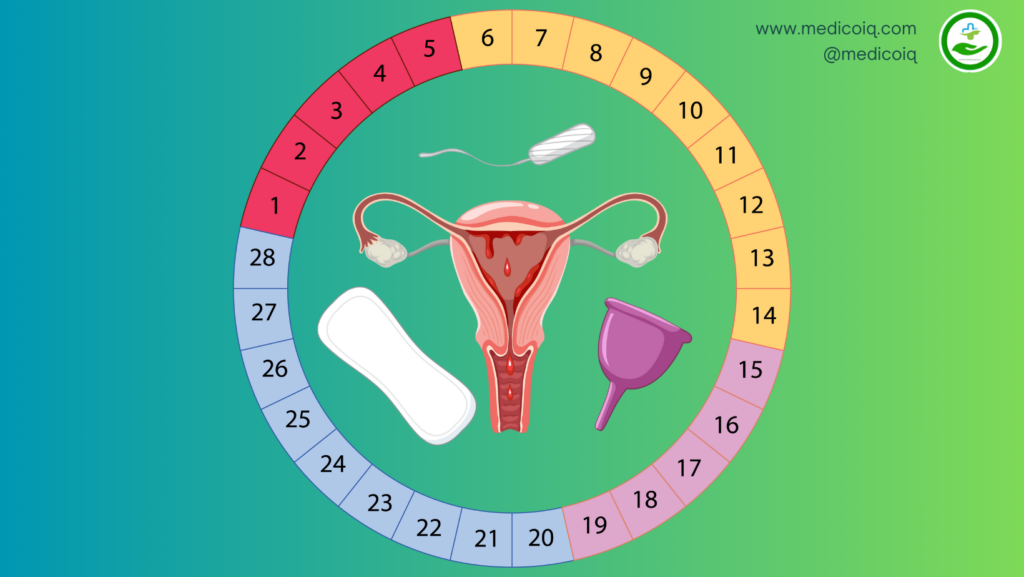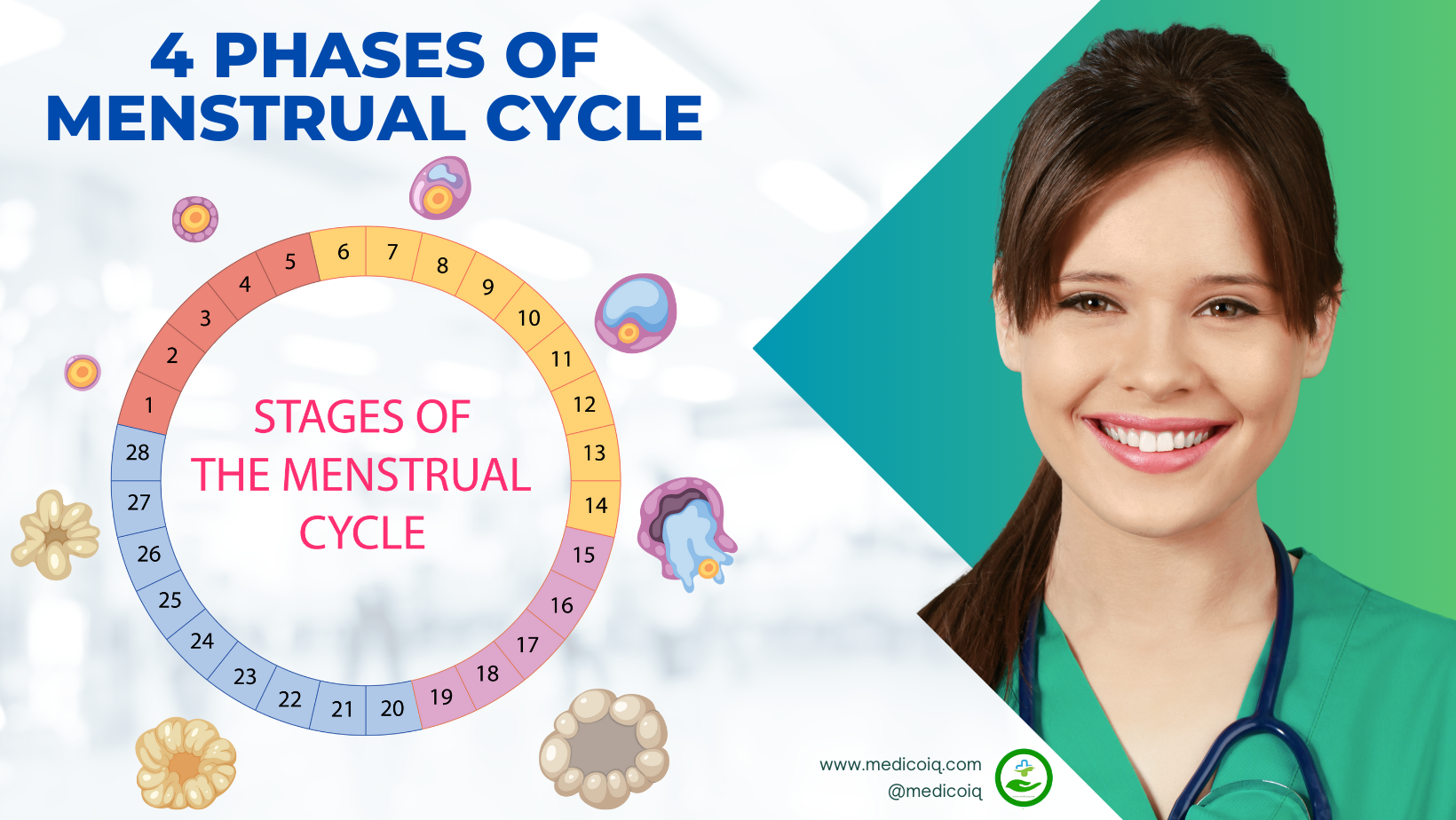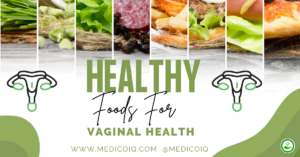Table of Contents
Brief Explanation 4 Phases of Menstrual Cycles:
The 4 phases of menstrual cycles is a natural process that occurs in the female body, typically lasting around 28 days, although it can vary from person to person. It involves a series of hormonal changes orchestrated by the reproductive system, preparing the body for potential pregnancy.
Importance of Understanding Menstrual Cycles for Overall Health:
Understanding the 4 phases of menstrual cycles goes beyond just knowing when your period will arrive. It is a vital aspect of female reproductive health that can provide insights into overall well-being.
By recognizing the various phases and their associated hormonal shifts, individuals can better comprehend their bodies and anticipate changes, empowering them to make informed decisions about their health and lifestyle choices.
The Four Phases:

1. Menstrual Phase (Days 1-5)
This phase marks the start of the menstrual cycle, characterized by the shedding of the uterine lining, resulting in menstruation. Hormone levels, particularly estrogen and progesterone, are at their lowest during this time, which may contribute to mood fluctuations and fatigue.
2. Follicular Phase (Days 1-13):
As menstruation ends, the body enters the follicular phase, during which the pituitary gland releases follicle-stimulating hormone (FSH), stimulating the ovaries to produce follicles.
Estrogen levels gradually rise, prompting the uterine lining to thicken in preparation for potential implantation.
3. Ovulation (Day 14):
Ovulation marks the release of a mature egg from the ovary, typically occurring around the middle of the cycle.
This phase is triggered by a surge in luteinizing hormone (LH), facilitating the egg’s journey into the fallopian tube, where it awaits fertilization by sperm.
4. Luteal Phase (Days 15-28):
Following Ovulation, the ruptured follicle transforms into the corpus luteum, releasing progesterone to support the thickened uterine lining. If fertilization does not occur, hormone levels decline, signaling the end of the cycle and initiating menstruation once again.
Understanding the four phases of the menstrual cycle is paramount for women’s health. By recognizing the intricate interplay of hormones and bodily processes, individuals can better manage their reproductive health and overall well-being.
Embracing these natural rhythms empowers women to take control of their health and navigate the diverse experiences of the 4 phases of menstrual cycles with confidence and understanding.
Understanding the 4 Phases of Menstrual Cycle
Menstrual Cycle Overview

1. Definition of Menstrual Cycle:
The 4 phases of menstrual cycles refers to the natural monthly process experienced by individuals with female reproductive systems.
It involves a series of hormonal changes and physiological events that prepare the body for potential pregnancy. Central to the menstrual cycle is the shedding of the uterine lining, known as menstruation, which typically occurs if fertilization does not take place.
2. Typical Duration of a Menstrual Cycle:
While the 4 phases of menstrual cycles duration can vary among individuals, a typical cycle lasts around 28 days, with day one marked by the onset of menstruation.
However, it’s essential to note that cycles can range anywhere from 21 to 35 days and still be considered normal. Factors such as stress, diet, exercise, and underlying health conditions can influence cycle length.
3. Role of Hormones in Regulating Menstrual Cycles:
Hormones play a pivotal role in orchestrating the various 4 phases of menstrual cycle. The key hormones involved include estrogen, progesterone, follicle-stimulating hormone (FSH), and luteinizing hormone (LH).
These hormones work in harmony to regulate the development and release of eggs from the ovaries, as well as the thickening and shedding of the uterine lining.
Exploring the Four 4 Phases of Menstrual Cycle
1. Menstrual Phase
2. Follicular Phase
3. Ovulation Phase
4. Luteal Phase
Understanding Symptoms and Changes Throughout the Menstrual Cycle
1. Common Symptoms Experienced During Each Phase
Throughout the 4 phases of menstrual cycles, individuals may experience a variety of symptoms and changes as their bodies undergo hormonal fluctuations. Understanding these symptoms can help individuals better manage their menstrual health and overall well-being.

2. Signs of Irregularities or Potential Health Concerns
While some variation in menstrual cycles is normal, certain signs may indicate irregularities or underlying health concerns that warrant further evaluation by a healthcare provider.
In conclusion, understanding the symptoms and changes that occur throughout the menstrual cycle is essential for maintaining menstrual health and identifying potential concerns.
By monitoring symptoms and seeking medical attention for any irregularities or unusual changes, individuals can take proactive steps to prioritize their reproductive health and overall well-being.
Managing Menstrual Cycle Symptoms: Tips and Strategies
For many individuals, the 4 phases of menstrual cycles brings a range of physical and emotional symptoms that can impact daily life. However, there are various strategies and techniques available to help manage these symptoms effectively.
1. Tips for Managing Menstrual Cramps and Discomfort:


2. Strategies for Tracking Menstrual Cycles:
FAQS Of 4 Phases of Menstrual Cycle
What are the 4 phases of the menstrual cycle?
The menstrual cycle consists of four main phases: the menstrual phase (menstruation), the follicular phase, ovulation, and the luteal phase.
These phases together make up the entire menstrual cycle, which typically lasts about 28 days but can vary from woman to woman.
What happens during the menstrual phase?
During the menstrual phase, also known as menstruation, the uterine lining sheds, resulting in vaginal bleeding. This phase marks the beginning of the menstrual cycle and usually lasts 3-7 days. Hormone levels are low during this phase.
Describe the follicular phase of the menstrual cycle.
The follicular phase begins on the first day of menstruation and lasts until ovulation. During this phase, follicle-stimulating hormone (FSH) stimulates the growth of ovarian follicles, each containing an egg. The lining of the uterus begins to thicken in preparation for a potential pregnancy.
What is ovulation and when does it occur?
Ovulation is the release of a mature egg from one of the ovarian follicles. It typically occurs around the middle of the menstrual cycle, approximately 14 days before the start of the next menstrual period. Ovulation is triggered by a surge in luteinizing hormone (LH).
What happens during the luteal phase?
The luteal phase begins after ovulation and lasts until the start of menstruation. During this phase, the ruptured follicle transforms into the corpus luteum, which produces progesterone. Progesterone helps prepare the uterine lining for a potential pregnancy.
If fertilization does not occur, hormone levels drop, leading to the shedding of the uterine lining and the start of a new menstrual cycle.
How long is the menstrual cycle on average?
On average, the menstrual cycle lasts about 28 days, starting from the first day of one period to the first day of the next. However, menstrual cycles can range from 21 to 35 days in adults and from 21 to 45 days in young teens.
It’s essential to note that variations in cycle length are normal and can be influenced by factors like stress, diet, and exercise.
Conclusion: Understanding and Embracing the 4 Phases of Menstrual Cycle
Recap of the 4 Phases of Menstrual Cycles:
The menstrual cycle is a natural and essential process that occurs in individuals with female reproductive systems.
It consists of four distinct , each characterized by unique hormonal changes and physiological events:
Encouragement for Readers to Understand and Track Their Menstrual Cycles for Better Health Management:
Understanding and tracking the menstrual cycle is essential for maintaining reproductive health and overall well-being.
By familiarizing themselves with the phases of their menstrual cycles, individuals can gain valuable insights into their bodies and anticipate changes more effectively.
Tracking menstrual cycles allows for early detection of irregularities or abnormalities, enabling timely intervention and management of potential health concerns.
Moreover, understanding menstrual cycles empowers individuals to make informed decisions about their health and lifestyle choices. Whether it’s managing menstrual symptoms, optimizing fertility, or practicing contraceptive methods, knowledge of the 4 phases of menstrual cycles plays a crucial role in health management.
Therefore, I encourage readers to take an active role in understanding and tracking their menstrual cycles.
Whether through traditional methods like calendar tracking or modern tools such as mobile apps, finding a tracking method that works for you can be empowering and beneficial.
Additionally, don’t hesitate to seek guidance from healthcare providers if you have concerns or questions about your menstrual health.
Ultimately, embracing and understanding the 4 phases of menstrual cycles is a journey toward better self-awareness, reproductive health, and overall well-being.
By prioritizing menstrual health management, individuals can take control of their bodies and lead healthier, more fulfilling lives.







